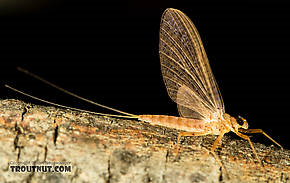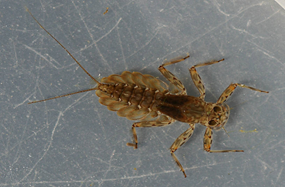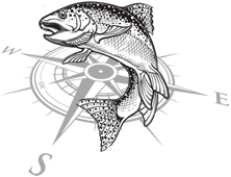Pink Albert, Pink Lady, Slate Brown Dun

Epeorus Albertae Pink Albert Dun

Epeorus Albertae Nymph
Underwater Epeorus Albertae or the Pink Albert is easy to identify because it’s the only clinger mayfly nymph with 2 tails. You will find the Pink Albert in selected rivers across the Northwest. The Dun is easily identified by what looks like a solid dark tan Mayfly. The body of the Pink Albert can range from a dull pink to a full tan body and begin hatching in the west in some areas as early as June and can continue through August. On some rivers such as the South Fork Boise River in Southern Idaho the Pink Albert is the dominant mayfly on the river.
The Pink Albert nymph, along with having only two tails, is a clinger mayfly that characteristically has a flattened body which help to keep its profile low while fighting the current. Its length can be up to 17mm and tends to have a medium brown body. You should be able to see the dark wing pads and large gills on its lower body. A good matching nymph size is a size 16 or 14 Pheasant Tail Nymph.
The Pink Albert nymph is a clinger and not a swimmer so when the nymph is dislodged underwater it will often drift quite a distance before being able to right itself to a point where it can latch onto some underwater structure. Because of this trait nymphing a pattern that closely matches the natural can be very effective way to sub-surface fly fish.
The Dun or sub amigo stage of emergence is the most important stage to fly fishermen. Epeorus Albertae like all mayflies emerge from a nymphal shuck. However with the Epeorus Albertae the emergence from nymphal shuck to dun will take place on the bottom of the river or just off the bottom. This event is critical information to the angler who is in the middle of a Pink Albert hatch. This event tells us that as far as mayflies go, this is an uncomplicated metamorphosis. That means it’s an easy hatch to match.
Unlike the Pink Albert, the PMD mayfly or pretty much any mayfly the PMD has a complicated metamorphosis in that the nymphal phase of the hatch has the nymph swimming from the bottom to reach its final destination which is the meniscus. The last I looked here at Northwest School of Fly Fishing in Boise we had over 54 patterns on an emerging PMD mayfly. Whereas the Epeorus Albertae or Pink Albert has only one, a tan soft hackle representing an emerging Pink Albert.
So the reality of the Pink Albert is it’s an easy hatch to work over. The simplicity of the hatch is that all you really need is a couple of real good dun patterns and one tan soft hackle. Couple that with a river where the dominate mayfly is the Epeorus Albertae and you will have a good day’s fishing casting to rising trout. Epeorus Albertae need fast clean moving water to flourish and when the emergence is on you will see trout packing the ends of tailouts where these bugs will eventually float through.

